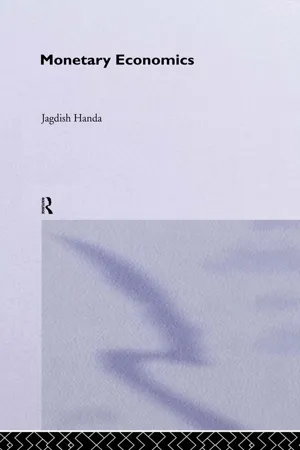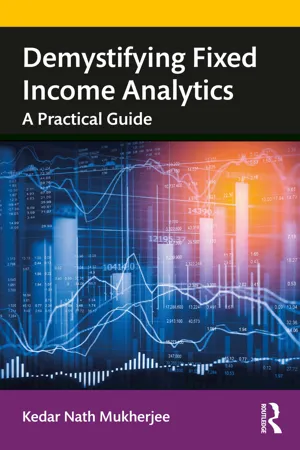Economics
Short Run Interest Rate
The short run interest rate refers to the interest rate on loans and financial instruments that is applicable over a relatively brief period, typically up to a year. It is influenced by factors such as central bank policies, inflation expectations, and market demand for credit. Changes in the short run interest rate can impact borrowing costs, investment decisions, and overall economic activity.
Written by Perlego with AI-assistance
Related key terms
2 Key excerpts on "Short Run Interest Rate"
- eBook - ePub
- Jagdish Handa(Author)
- 2002(Publication Date)
- Routledge(Publisher)
The relationship between expected return and risk is usually explained by the capital asset pricing model proposed by Sharpe (1964) and based on the expected utility hypothesis developed in Chapter 5 above. This model is briefly discussed in section 21.8 below and presented more fully in the appendix to this chapter. However, note that the theories on the risk structure and the term structure of interest rates only explain the interest rate differentials due to differences in risk or the term to maturity, and do not explain the basic interest rate in the economy, which was the subject of Chapter 20. Notation The notation in this chapter is quite cumbersome, so that some explanation on its general pattern would be useful. The short (one-period) interest rates are designated by r. The current period is designated as t. Suppose that a contract is entered into in period t + j for a one-period loan for period t + i at an interest rate r. This will be written as t+j r t+i, where the left-hand-side subscript indicates the period in which the contract is made and the right-hand-side subscript indicates the period for which the loan is made. If future interest rates are expected ones, we would write the corresponding rate as t+j r e t+i whose rational expectations would be written as E t+j r t+i where the expectations are based on information available in period t + j. The long rates are designated by R. The contract for these is always assumed to be entered into in the current period t. t R t+i will designate the long rate on a contract for a loan of i periods. Since this interest rate is known in the current period, it is an actual rather than an expected rate. 21.1 SOME OF THE CONCEPTS OF THE RATE OF INTEREST The short-term markets for bonds have the spot, forward and long rates of interest - eBook - ePub
Demystifying Fixed Income Analytics
A Practical Guide
- Kedar Nath Mukherjee(Author)
- 2020(Publication Date)
- Routledge India(Publisher)
The interest rate is the rate that is charged or paid for the use of money and is expressed as an annual percentage of the principal. From an investor’s perspective, the interest rate is the annual return which he/she generates from her/his investment. Interest rate can be of two types: nominal and real interest rates. Nominal interest rates are normally positive, but real interest rates can be negative, depending upon the economic situation, especially the rate of inflation. The interest rate may change because of several factors; such as: inflationary expectations, alternative investments, risk of investment, liquidity preference, tax implication, and most importantly the maturity or period. Depending upon the length of the period, interest rates could be short term (with less than one-year term) and long term (or a maturity above 1 year). In some cases, there could be some rates of medium term with a maturity between one to 5/10 years. Some important short-term rates are: interbank call rates of different maturity (LIBOR/MIBOR with 1-day, 1-month, 3-month, 6-month, 1-year); 1-day, 7-day, 14-day, 1-month repurchase (Repo) rates; 3-month, 6-month, 12-month deposit/lending rates, 91-day, 182-day, 364-day T-bill rates; short-term swap rates, etc. On the other hand, some of the long-term rates include: yield on long-term government securities, corporate bond yields, bank lending rates, long-term swap rates, etc.Some important interest rates in Indian debt marketBenchmark rateThe benchmark interest rate, alternatively known as base interest rate, is the minimum interest rate that investors will demand for their non-governmental investment, say a non-Treasury security. It is also tied to the yield to maturity offered on on-the-run (most recently issued) Treasury security of comparable-maturity. Alternatively, a benchmark rate is an interest rate against which other interest rates are calculated. For example, a benchmark rate could be the interest rate at which the central bank of an economy (here RBI) gives loans (borrows money) to (from) the commercial banks under their jurisdiction, which further can be used as a benchmark by the commercial banks to decide the interest rate for their loan or deposit products of different maturity. The interest rate at which commercial banks and other selected FIs can borrow (lend) money from (to) the Reserve Bank of India is called Repo Rate (Reverse Repo Rate), which is presently (as on December 2019) at 5.15% (4.90%). At the same time, the other benchmark rate, offered by the central bank, in India is the Marginal Standing Facility (MSF) Rate, and Bank Rate, which is presently (as on December 2019) at 5.40%. In the case of borrowing under Repo from RBI through the Liquidity Adjustment Facility
Learn about this page
Index pages curate the most relevant extracts from our library of academic textbooks. They’ve been created using an in-house natural language model (NLM), each adding context and meaning to key research topics.

